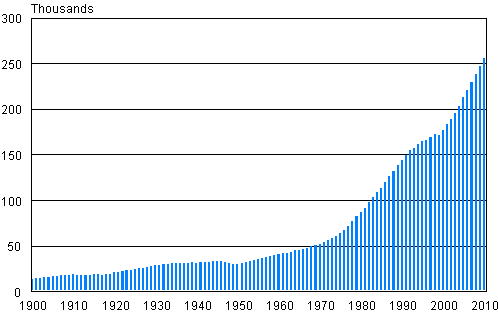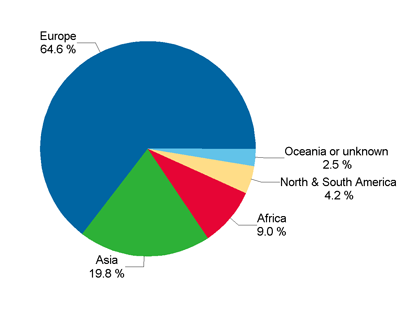Published: 18 March 2011
Over quarter of a million aged 80 and over in Finland
According to Statistics Finland's statistics on the population structure, there were 255,912 persons aged 80 and over in Finland's population at the end of 2010. The number has grown five-fold over the last 40 years. The clear majority of those aged 80 and over were women, as the number of men was 81,205 and that of women 174,707.
Number of persons aged 80 and over in Finland's population in 1900–2010

At the end of 2010, the official total population of Finland was 5,375,276, of whom 2,638,416 were men and 2,736,860 women. In the course of 2010, Finland’s population grew by 23,849 persons. For the fourth successive year migration gain from abroad contributed more to the increase of population than natural growth.
During 2010, the number of persons aged 65 and over in the population increased by good 30,000 persons and totalled 941,041 at the end of 2010. The largest age cohort in Finland’s population was persons born in 1948 (82,048 persons). Persons over 100 years of age numbered 622, of whom 93 were men and 529 women.
Every fifth person born abroad came from Asia
A total of 248,135 foreign nationals lived in Finland at the end of 2010. The majority of those born abroad (65 per cent) were born in Europe. Next came those born in Asia (20 per cent) and Africa (nine per cent). Seventeen per cent of those born abroad speak Finnish as their native language.
Persons born abroad living in Finland at the end of 2010 by continent of birth

Of the population of Finland 4,857,903 persons (90.4%) spoke Finnish, 291,153 persons (5.4%) Swedish and 1,832 persons (0.03%) Sami as their native language. Persons with a native language other than Finnish, Swedish or Sami numbered 224,388, or 4.2 per cent of the population. The largest foreign-language groups spoke Russian (54,559 persons), Estonian (28,493 persons), Somali (12,985 persons), English (12,855 persons) and Arabic (10,415 persons).
At the end of 2010, the number of Finnish citizens permanently resident in Finland was 5,207,322, of whom 97,338 had been born abroad. Foreign citizens resident in Finland numbered 167,954, or 3.1 per cent of the population.
At the end of 2010, 54,912 persons living in Finland had another nationality in addition to Finnish citizenship. The largest dual nationality groups were citizens of Russia (15,348), Sweden (5,275) and the United States (3,220). In statistics these persons are classified as Finnish citizens.
Population increased in 10 regions and in 137 municipalities
The number of regions decreased by one as the regions of Itä-Uusimaa and Uusimaa were united. During 2010 the population increased in 10 and decreased in nine regions. In absolute numbers the population grew most in the regions of Uusimaa, by 14,767 persons, and Pirkanmaa, by 3,487 persons. In relative terms the population grew most in the regions of Åland and Uusimaa, by 1.0 per cent.
In absolute numbers the population decreased most in the regions of Etelä-Savo, by 900 persons, and Kainuu, by 561 persons. In relative terms the population decreased most in the regions of Kainuu, by 0.7 per cent and Etelä-Savo, by 0.6 per cent.
Six municipal mergers took effect as of the beginning of 2011, in consequence of which the number of municipalities in Finland decreased by six. There are now 336 municipalities in Finland. During 2010, the population grew in 137 and diminished in 197 municipalities.
Helsinki had the biggest absolute increase in population, 5,199 persons, followed by Espoo (3,640 persons) and Oulu (2,538 persons). Pieksämäki had the biggest absolute decrease in population (282 persons), followed by Jämsä (258 persons) and Kauhava (237 persons). In 2010, the population of Vantaa was the fourth municipality to exceed the 200,000 mark.
Demographic dependency ratio highest in Etelä-Savo and lowest in Uusimaa
The demographic dependency ratio, that is, the number of under 15 and over 65-year-olds per 100 working age persons was 51.6 at the end of 2010. Examined by area, the demographic dependency ratio was highest in the regions of Etelä-Savo, 59.5, and South Ostrobothnia, 58.5.
The demographic dependency ratio was lowest in the regions of Uusimaa (44.9) and Pirkanmaa (51.1). Examined by municipality, the demographic dependency ratio was highest in Luhanka, 91.0, Kivijärvi, 84.1, and Multia, 80.9, and lowest in Helsinki, 39.9, Tampere, 42.4, and Oulu, 42.5.
Source: Population Structure 2010, Statistics Finland
Inquiries: Markus Rapo (09) 1734 3238, vaesto.tilasto@stat.fi
Director in charge: Jari Tarkoma
Publication in pdf-format (391.9 kB)
- Tables
-
Tables in databases
Pick the data you need into tables, view the data as graphs, or download the data for your use.
Appendix tables
- Figures
-
- Appendix figure 1. Population in Finland 1750 - 2010 (18.3.2011)
- Appendix figure 2. Country of birth, citizenship and mother tongue of the population 31.12.2010 (18.3.2011)
- Appendix figure 3. The largest groups by native language 2000 and 2010 (18.3.2011)
- Appendix figure 4. Foreign nationals by sex 1980 - 2010 (18.3.2011)
- Appendix figure 5. Population change by municipality 1980 - 2010, per cent (18.3.2011)
- Quality descriptions
-
- Quality description: Population structure 2010 (18.3.2011)
Updated 18.3.2011
Official Statistics of Finland (OSF):
Population structure [e-publication].
ISSN=1797-5395. 2010. Helsinki: Statistics Finland [referred: 17.11.2025].
Access method: http://stat.fi/til/vaerak/2010/vaerak_2010_2011-03-18_tie_001_en.html

